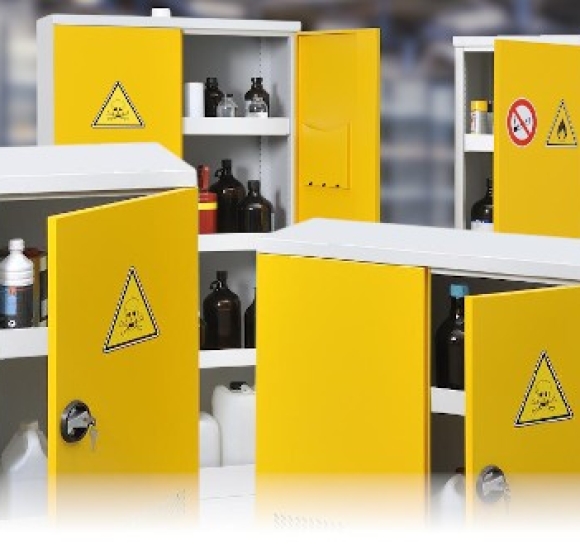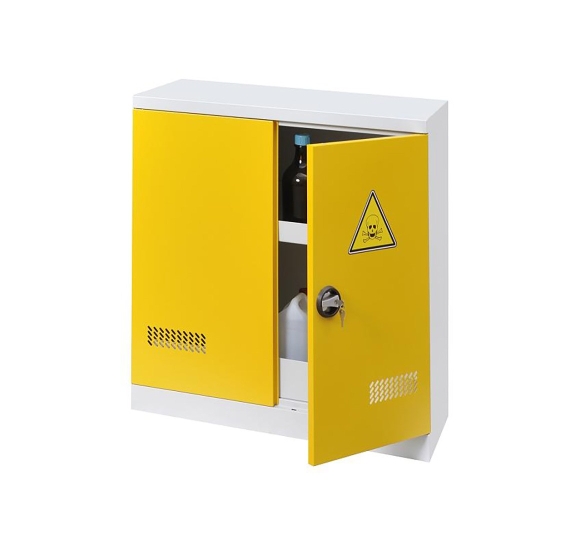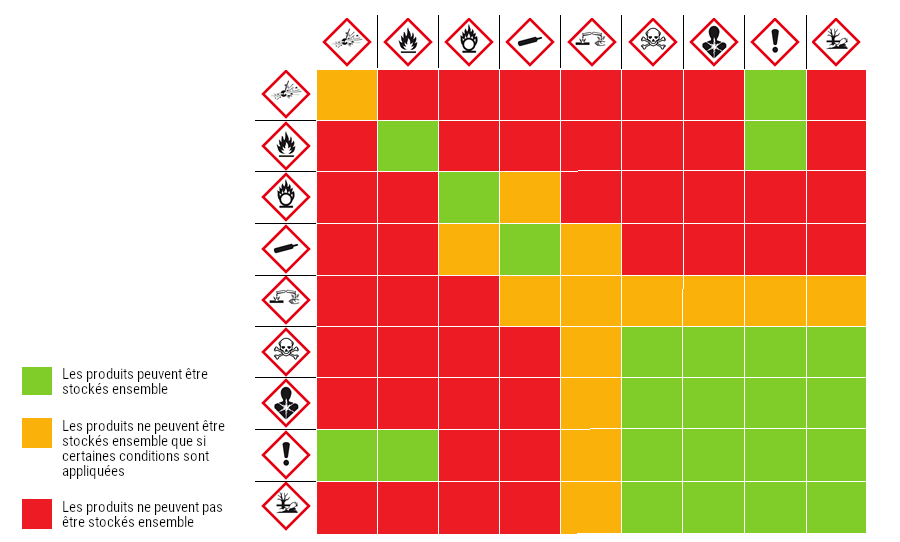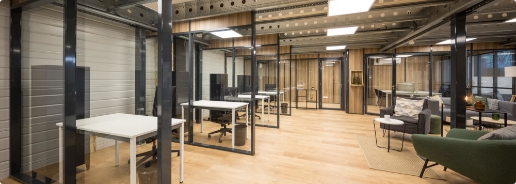
Choosing a chemical storage cabinet
Provost, France's leading manufacturer of shelving and storage solutions, can help you with all your business projects, and offers a complete range of plant protection, safety and security cabinets for storing products that are hazardous and harmful to personnel.

Role of safety cabinets for hazardous products
Safeguarding and storing chemical, toxic, corrosive, carcinogenic and flammable products...
Identify and facilitate the management of various phytosanitary, flammable or harmful products.
Protect the environment and users in the event of product leakage or fire.

Choose your cabinet according to your specific needs
Hazardous products, including cleaning products, are present in most areas of activity.
4 criteria enable you to select the cabinet best suited to your needs:
- Type of products, checking for chemical compatibility
- Cabinet size to fit your workspace
- Volume and weight of products to be stored
- Ventilation system
How to choose your wardrobe: Selection criteria
1st criterion: Type of product
3 cabinet families are available, depending on the type of product to be stored:
- Phytosanitary cabinet for the storage of environmentally hazardous products.
- Safety cabinet for storing toxic or flammable products
- Safety cabinets with 30 or 90-minute fire resistance (depending on flash point) for flammable products.
| New pictograms | Description | Storage solution |
| Flammable: products that can ignite very easily in the presence of an ignition source | Safety cabinet for flammable products or safety cabinet (30 or 90 minutes) | |
| Combustible: chemical substances which have the property of allowing the combustion of combustibles | Flammable safety cabinet or safety cabinet (30 or 90 minutes) | |
| Explosive: products capable of exploding on impact or from a source of ignition | Safety cabinet (90 minutes) | |
 |
Gas: pressurized gases contained in a container, risk of explosion or burns | Cabinet for gas cylinders |
 |
Harmful/irritating: repeated contact causes inflammatory reactions with skin or mucous membranes. Can cause poisoning in large doses | Safety cabinet for toxic products |
| Corrosive: substances that damage living tissue (skin, eyes, mucous membranes) | Safety cabinet for toxic products with HDPE anti-corrosion protections | |
| Toxic: substances presenting a health hazard, even in small quantities | Safety cabinet for toxic products | |
| Dangerous for humans: products that may be carcinogenic, mutagenic or teratogenic. They can also alter the functioning of certain organs. | Safety cabinet for toxic products | |
| Dangerous for the environment: substances toxic to wildlife, aquatic organisms and the ozone layer | Plant protection cabinet |
CAUTION: Incompatible products must not be stored in the same cabinet.
Chemical compatibility table
Some chemicals may interact with each other. These interactions can lead to explosions, fires, splashes or the emission of dangerous gases. These incompatible products must be stored separately to avoid accidents.
Even if they display the same pictogram, some products cannot be stored together. Consult the safety data sheet (SDS), instructions for use, storage and safety instructions or contact your supplier.

The choice of cabinet is based on its ability to withstand fire:
| Flash point | Type of product | Cabinet |
| PE<0°C | Extremely flammable | safety fire resistance 90 minutes |
| 0°C<PE<21°C | Highly flammable | safety fire resistance 60 minutes |
| 21°C<PE<55°C | Flammable | 30-minute fire resistance |
| PE>55°C | Low flammability | 15-minute fire resistance or safety cabinet for flammable products |
For flammable products, the Flash Point (PE) value determines the type of safety cabinet to be purchased. These are metal cabinets specially designed to store containers of extremely and/or easily flammable and combustible liquids, to protect them against two sources of fire propagation: flames and heat.
The Flash Point is the minimum temperature at which a liquid at atmospheric pressure emits sufficient vapors to ignite in the presence of a flame. The lower the Flash Point, the more flammable the product.
In accordance with the European "CLP" regulation, chemical product manufacturers are obliged to label each container and provide a "safety data sheet" for each product. Take advantage of our range of hazard pictograms to help you comply.
2nd criterion :
cabinet format Several formats are available to suit your workspace and your needs.
- Low cabinets (1 or 2 doors)
- Tall cabinets. (1 or 2 doors)
- Under-bench cabinets. They can be placed under your worktop to store bottles for regular use. (On request)
3rd criterion: container volume and weight
The size of the products to be stored is also important when choosing a cabinet. Depending on the volume, weight and number of containers, the cabinet will not be the same.
4th criterion: Ventilation system
For tall cabinets, it is possible to install a ventilation box. This extends the life of the cabinet by combating corrosive vapors and preventing poisoning caused by the accumulation of dangerous gases.
Room equipped with VMC: You can opt for a ventilation box connected to this VMC to evacuate the air from the cabinet to the outside of the building.
Room without CMV: You'll need to add a filter box to purify the air and return it to the room. The type of filter best suited to the products stored in the cabinet must be determined.
To find out more, consult the list of decrees & standards
Order of February 2, 1998:
Any product likely to pollute water or soil must be stored in a containment tank.
European standard EN14470-1
Concerns flammable products in laboratories. Flammable products used and handled in laboratories must be stored in one or more safety cabinets with a minimum fire resistance of 15 minutes. 4 types of fire resistance: 15, 30, 60 and 90 minutes.
Article R.5132-66:
Dangerous substances or preparations are kept in locked cabinets or in premises to which outsiders do not have free access.
Article R.5132-68:
Incompatible products must be stored in separate cabinets or compartments.
Decree no. 87-361 of May 27 1987:
- Article 3: Pest control products must be kept in their original packaging until they are used;
- Article 4: Pest control products must be stored in a room reserved for this purpose. This room must be ventilated or aired. It must be locked if it contains pest control products classified as highly toxic, toxic, carcinogenic, teratogenic or mutagenic. This key is kept by the employer;
- Article 5: Only equipment reserved for the use of pest control products may be used. The utensils also reserved for this use must be placed in a room provided for in article 4 above;
- Article 8: After cleaning, protective equipment must be placed in an individual locker intended for this purpose only and located in a room other than that referred to in article 4 above;
- Article 10: The employer must prohibit workers from smoking, drinking and eating during any exposure to pest control products and before any body cleansing has been carried out.





